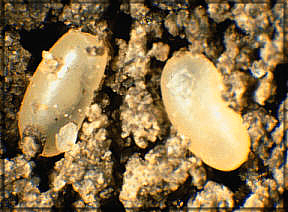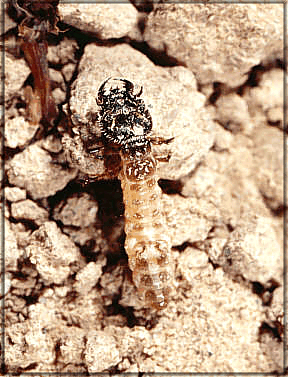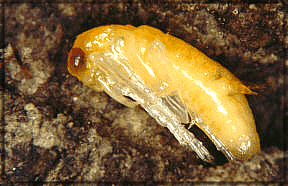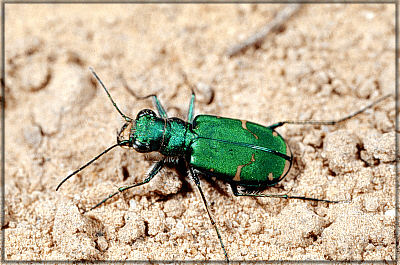 Egg
Egg
 Egg
Egg
Eggs are laid in the soil, usually singly, in a burrow made by the female’s ovipositor (an egg laying tube at the end of the female’s abdomen). The female often covers the oviposition site with soil to discourage predators.
 Larva
Larva
The newly-hatched larva enlarges the hole and burrows perpendicularly to the soil surface. This is accomplished byloosening the soil with its mandibles and using its head and thorax like a shovel to carry the soil. At the surface, the larva flips the soil backward off its head. There are three larval stages, and larvae enlarge and lengthen their burrow as they grow. The burrow may be 18 inches or more in depth, depending on the substrate. While in their burrows, larvae can survive without food for weeks and can also survive temporary flooding. They do not leave their burrow under normal circumstances but often wait at the burrow entrance to ambush small arthropods. When a suitable victim is near, the larva attacks with lightning speed. It throws its head (usually backward) to grab the prey with its sickle-shaped jaws. Then, it pulls the prey down into the burrow to devour it. Somewhat like a spider, larvae secrete digestive enzymes to help break down their food before ingestion. Tiger beetle larvae are unique in that they have hooks located on the back of their abdomen to anchor them to the side of the burrow while they subdue large prey. Tiger beetle larvae, in turn, are fed on by hister beetles, birds, and ants, and are parasitized by bombyliids (bee flies) and several wasps. The larval period may last up to four years depending on the species.
 Pupa
Pupa
The third stage larva forms a pupal cell within the burrow a few inches from the soil surface. It plugs the burrow entrance with soil prior to pupation. The pupa does not feed, and is the transitional stage between larva and adult. Pupation lasts three or more weeks.
 Adult
Adult
After emergence from the pupa, the adult must wait about three days before digging itself out of the burrow so that its exoskeleton will have time to harden. Even after emergence from the burrow, the adult is still soft and light colored and may be easy prey for predators.
Mating occurs soon after emergence, but repeated mating may occur throughout the lifespan of the adult. To prevent immediate re-mating, males exhibit a behavior known as mate-guarding or contact-guarding. The male uses his large mandibles to grab the female’s thorax. Then he rides on top of the female for a prolonged period of time after mating to discourage other suitors.
Often subjected to high temperatures on the salt flats, adults regulate their temperature by altering their behavior. This includes seeking wetter areas, digging burrows, hiding in the shade, or using their long legs to stilt themselves as far above the soil surface as possible. Although tiger beetles are cold blooded, these behaviors give tiger beetles some control over their body temperature and help them avoid lethal temperatures on the very hot salt flats during the summer.
Adults feed on just about anything they can see and catch, including invertebrates that may be larger than themselves. Their vision seems acute, as any movement (even by a human at a distance) causes the beetle to turn and face the source of the motion. Beetles, flies, caterpillars, ants, grasshopper nymphs, and spiders are just a few of the invertebrates reported as tiger beetle prey. Although most tiger beetles are wary and not easily approached, they are also preyed upon. Predators of tiger beetles include dragonflies, robber flies, other tiger beetles, birds, and small vertebrates. Mites are also known to parasitize tiger beetles.